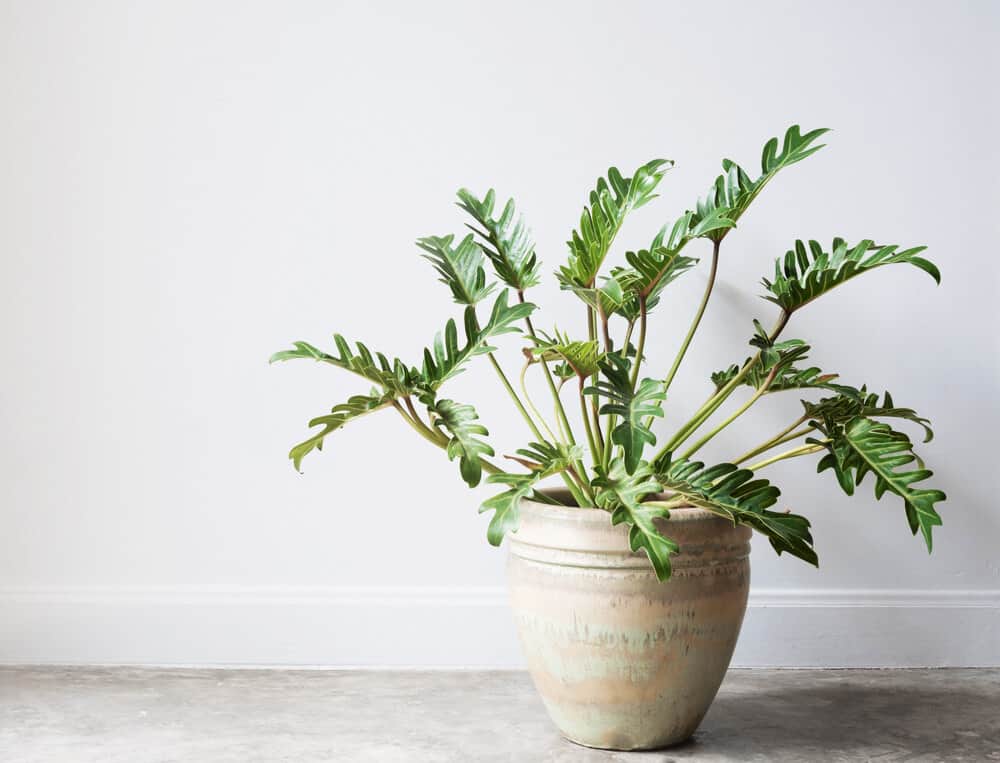If you want a quirky statement plant in your home, pick a philodendron Xanadu.
These tropical plants grow up to 1.5m, with dark green and feather-like leaves. They’re perfect for filling up sunny corners or creating a mini-jungle under a grow light!
Xanadu plant care is pretty straightforward — it’s low-maintenance and grows very well indoors. Your main concerns will be preventing root rot (Xanadus are fairly susceptible) and providing support for the stems.
Keep your Xanadu plant in a free-draining soilless mix (or even a mineral substrate) and bright, indirect light. Avoid full sun as it could scorch the leaves.
A healthy, happy Thaumatophyllum xanadu will reward you with large, lush foliage and bushy growth. Then you can show it off to friends and family — or even give them a division so they can have their own!
Soil Mix | Light Requirements | Pot and Support | Indoor Environment | Watering | Repotting | Fertilising | Pruning | Outdoor Care | Propagation | Plant Problems
X Marks the Xanadu Plant
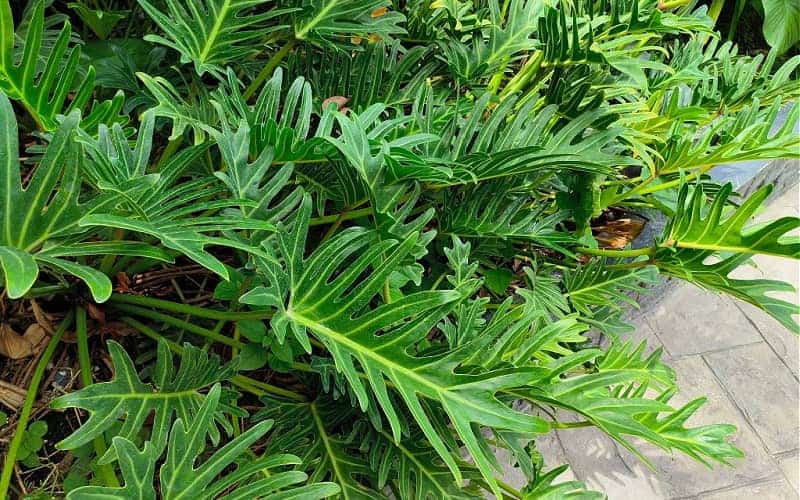
It might be confusing, but the philodendron Xanadu is actually not a type of philodendron!
The plant was reclassified as Thaumatophyllum xanadu in 2018, alongside a few other varieties. Its common name stuck around, though, and it’s still a member of the Arum family.
Another nickname was philodendron ‘Winterbourn’ before House Plants of Australia renamed it to ‘Xanadu’ in the 1980s.
Xanadus stand out thanks to their dark green leaves with a “feathered” appearance. Plus, with their upright growth and size, they make great statement plants!
There are a few T. xanadu varieties, such as the ‘Golden’ or ‘Gold Rush’, which has vibrant yellow-green foliage. There’s also the ‘Mini Xanadu’ that’s perfect for smaller spaces.
Growing Conditions for A Philodendron Xanadu
Xanadu plants aren’t too fussy — they just need chunky, well-draining potting mix and plenty of support to remain upright.
They’re not very tolerant of low light, though, so make sure they get plenty of medium to bright indirect light.
Soil or potting mix
Like many aroids, the ideal philodendron Xanadu soil is a rich, well-draining soil-less mix. Look for chunky potting mixes made for aroids.
If you can find some, Xanadus can thrive in a bonsai medium or a mineral substrate! Then you just need to supplement the plant with fertiliser to encourage healthy growth.
The key factor is drainage — Xanadu plants are prone to root rot, so you want a potting medium that doesn’t retain a lot of moisture.
Light requirements
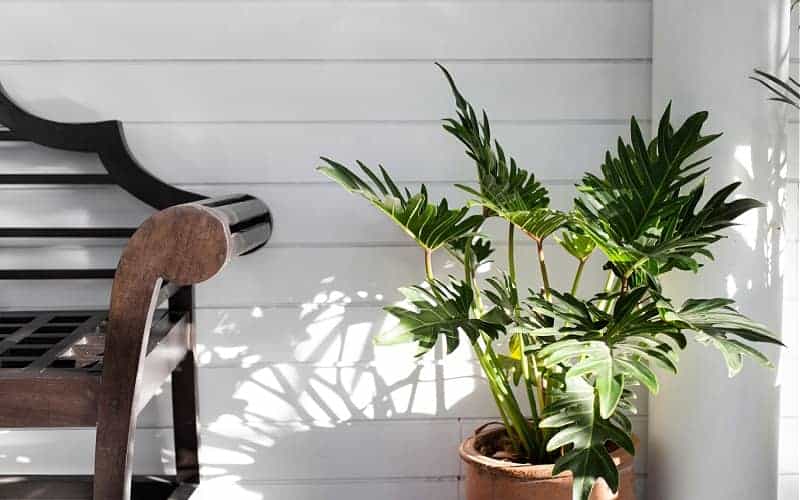
Xanadu plants are typically understory plants, so they’ll be fine in bright, indirect light or dappled sunlight.
For indoor plants in Australia, position them near an east or northeast-facing window. Be sure you can see the sky from where the plant sits — if not, they won’t get enough light.
Keep philodendron Xanadus out of full sun, though, especially in the afternoon. Overexposure can lead to leaf burn.
If you don’t have a nice, sunny spot indoors, consider an overhead full-spectrum grow light.
Pot and plant support
Philodendron Xanadus are self-supporting plants with thick stems. Given their long petioles and large leaves, they’ll benefit from a stake or pole to keep the foliage upright.
Use soft garden ties or jute string to tie stems to the support.
For the container, choose one with plenty of drainage holes. Remember that these plants can get quite large, so avoid using a pot that’s too heavy!
Indoor environment

Since they’re native to warm climates, Xanadus are happiest in similar environments — temperatures between 18º–30ºC and 40–70% humidity.
Standard household temps and humidity will be fine, though you can use a humidifier or group your plants together.
Philodendron Xanadus don’t have much cold tolerance, so avoid exposure to temps lower than 13ºC. For outdoor plants, bring them inside during winter or rainy weather.
In temperate climates, Xanadus are best grown indoors.
Philodendron Xanadu Indoor Care
Xanadus make great indoor houseplants, especially in large spaces like corners or living rooms.
Be sure not to overwater the plant, and keep an eye on the container — Xanadus are moderately fast-growing and don’t enjoy being pot-bound for long!
When to water a philodendron Xanadu
Err on the side of underwatering for your Xanadu plants! That means allowing the potting mix to get 50 to 75% dry between watering.
You can use a moisture meter or a wooden stick to test for soil moisture, especially as the plant gets larger and heavier.
Thoroughly soak the potting medium, then allow the excess water to drain out of the container. Alternatively, consider a bottom-watering saucer.
How and when to repot your Xanadu plant
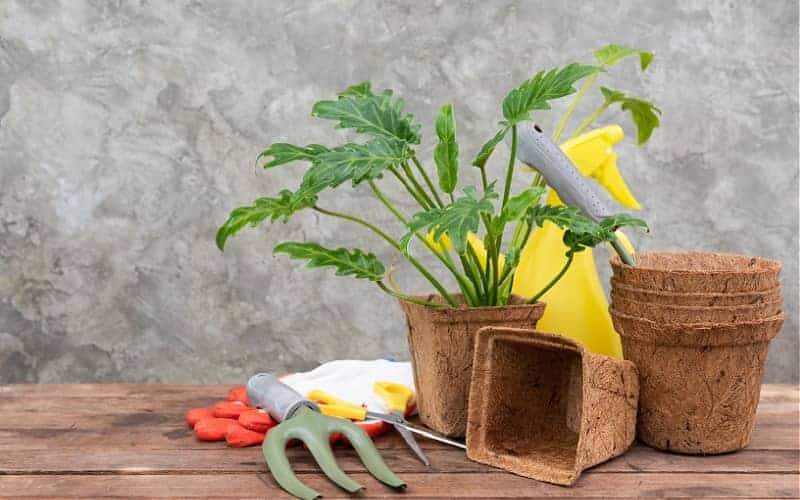
Philodendron Xanadus don’t tolerate being rootbound for long periods, so be ready to repot the plant once it outgrows its container.
Depending on how fast it’s growing, you may need to repot every 1–2 years.
Look out for signs such as:
- Slowed or stunted plant growth
- Roots emerging from drainage holes
- Soil that dries more quickly or frequently
To repot your philodendron Xanadu, choose a pot that’s 3–6cm (1–2in) larger than its current container.
Gently remove the plant from the existing pot and inspect the soil. If you find no issues (e.g. mould or rot), place the roots and soil together in the new pot.
Fill in the gaps with fresh potting mix and give the container a shimmy to settle things. Water the plant thoroughly.
Should you fertilise a philodendron Xanadu?
It’s best to fertilise your Xanadu during the growing season (spring and summer), especially if it has a soilless or inert (low-nutrient) potting medium.
Use a balanced houseplant fertiliser diluted to about half to one-quarter strength. This helps prevent fertiliser burn and salt build-up.
Do you need to prune a philodendron Xanadu?
There’s typically no need to prune a healthy Xanadu plant besides removing dead leaves or maintaining a compact growth habit.
If you must prune, use disinfected shears — or, for very large plants, loppers. In a pinch, you can also use a large box cutter.
When pruning a Xanadu, cut the petiole as close to the stem as possible. For stems, cut between the leaf nodes.
Philodendron Xanadu Outdoor Care
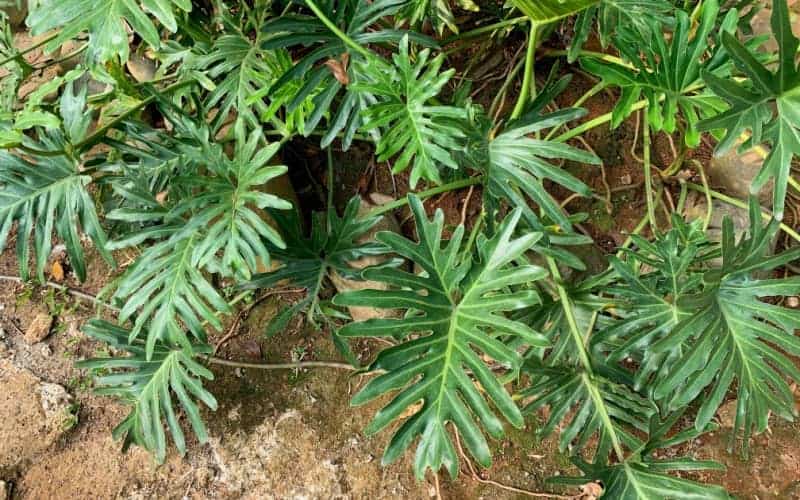
Xanadus are popular for understory or mass planting, since they grow well in the shade of trees and hedges. Their vigorous root systems also make them great for erosion control.
However, philodendron Xanadu roots can be invasive in outdoor settings. They tend to spread underground, though they’re not usually a hazard to sewage systems.
Check your local state or council regulations for any guidelines about planting in gardens.
When planted outdoors, position your Xanadus in partial shade or dappled sunlight. Avoid placing them where they get full sun in the afternoon.
These plants are more tolerant of dryness once established, so only water when the top 5–10cm of soil has dried. You can layer organic matter to help retain moisture for longer.
Xanadus may have overcrowded growth in gardens, so they’ll need a bit more maintenance. Keep an eye on the aerial roots to make sure they don’t become tangled or trap nearby leaves/stems.
Prune roots and stems when the plant’s foliage is too dense or unruly.
In ideal conditions, Xanadus can produce small, red flowers in spring or summer!
Philodendron Xanadu Propagation
The ideal way to propagate a Xanadu is via divisions — separating the plant at the roots.
To divide a philodendron Xanadu, remove it from its container and carefully pull off a “clump” of the plant from the root ball or rhizome. If you need to cut into the plant, use disinfected shears and allow the cut section to callous.
Plant the division in a small pot with fresh potting mix, then wait a few days before watering.
You can also propagate a philodendron Xanadu in water through cuttings.
Look for a healthy shoot with a few leaf nodes or aerial roots. Make a clean cut between nodes/roots, around 8–15cm from the tip.
Remove any leaves on the bottom half of the stem, then place the cuttings in a clear container. Add enough water to cover the bottom nodes and keep the cuttings in bright, indirect light.
You should start seeing new roots after a few weeks. Wait until secondary roots have come in before transferring the cuttings to small pots.
Keep the potting medium consistently moist for 1–2 weeks while the roots establish themselves.
Philodendron Xanadu Plant Problems
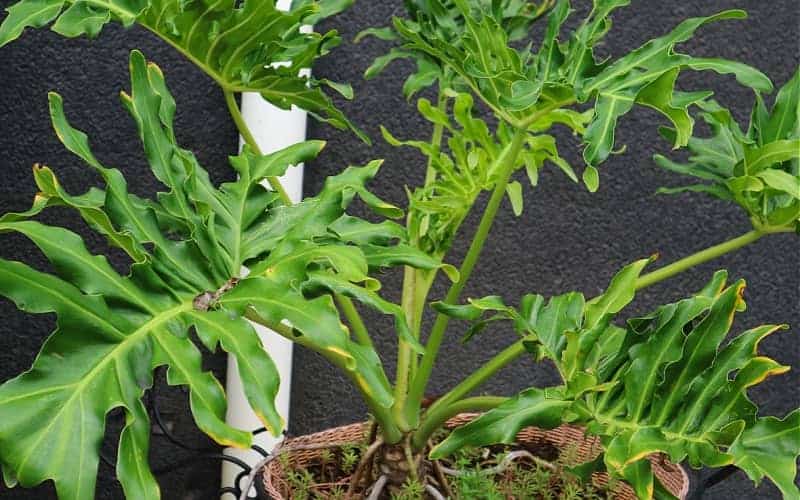
Xanadus are fairly resilient plants, but they’re fairly sensitive to overwatering and leaf burn.
You may also get pests, especially for plants grown outdoors.
Why are my Xanadu plant leaves turning yellow?
One or two yellow leaves are just part of a plant’s life cycle, but many yellowed and wilting leaves can be a sign of root rot.
Overwatering (or watering too often) is a common culprit. If the soil does not sufficiently dry, it can suffocate the roots and lead to rot.
Poor drainage, incorrect pot size, and cold temperatures can also prevent the soil from properly drying.
Check the plant’s roots ASAP — black, mushy, or bad-smelling growth is a sign of rot. Rinse off the soil and cut off affected roots with disinfected shears, then spray with a little 3% hydrogen peroxide.
Give your Xanadu some fresh potting mix and wait a few days before watering again.
Why are my philodendron Xanadu leaves brown?
Brown foliage can be a sign of underwatering or too much sun.
Brown and crispy leaves mean your plant is underwatered. For smaller containers, dunk them in a shallow bucket of water to thoroughly saturate the growing medium.
Larger plants can be soaked with a hose. Use a wooden stick to ensure the soil is wet all the way through.
If the foliage has brown or yellow tips, then your Xanadu is suffering from leaf burn — too much sun. Move the plant away from the window or protect the leaves from direct sunlight.
Philodendron Xanadu pests or diseases
Xanadus are hardy plants, so they usually aren’t prone to fungal diseases except root rot.
They may also suffer from pest infestations such as mealy bugs, spider mites, and thrips. Monitor the leaves and soil surface for signs of pests.
Treat any infestations with pruning and an insecticidal soap spray.
More to Know About Xanadu Plants: FAQs
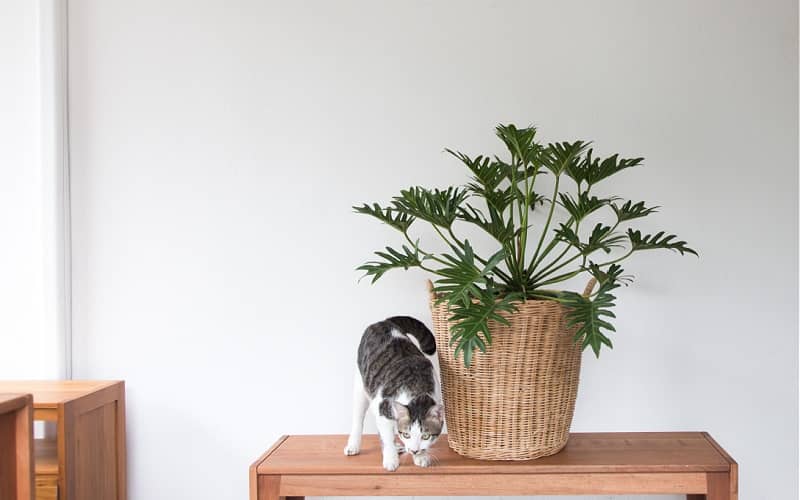
Got more questions about a Xanadu plant? Here are some that people ask a lot!
Is Philodendron Xanadu a monstera?
No — but they’re related! Both Xanadu plants and monsteras are under the Araceae family, commonly known as aroids.
While the Xanadu looks like the ever-popular Monstera deliciosa, they’re different plant species.
Philodendron Xanadu vs Philodendron Selloum
Both the philodendron Selloum (T. bipinnatifidum) and Xanadu were reclassified from the Philodendron genus to the Thaumatophyllum genus. They’re closely related but not the same plant!
The key differences between the Xanadu and Selloum are height and leaf size.
Selloum plants are tall, with some varieties reaching 2.0m or more. The angular foliage can grow to 1.2m long and 45cm wide.
On the other hand, Xanadu plants do not get as big — up to 1.5m tall and 2.0m wide. They have flatter leaves that typically grow up to 40cm long and 30cm wide.
Additionally, Xanadus tend to have a more compact growth habit, while Selloums will spread up and out.
Is a Xanadu philodendron toxic to pets?
Yes! Even if it’s been reclassified, the Thaumatophyllum xanadu is still toxic to pets, including cats and dogs.
Ingestion can cause gastrointestinal irritation and potential allergic reactions. If you think your pet has eaten, chewed on, or licked your plant, take it to a vet ASAP.

